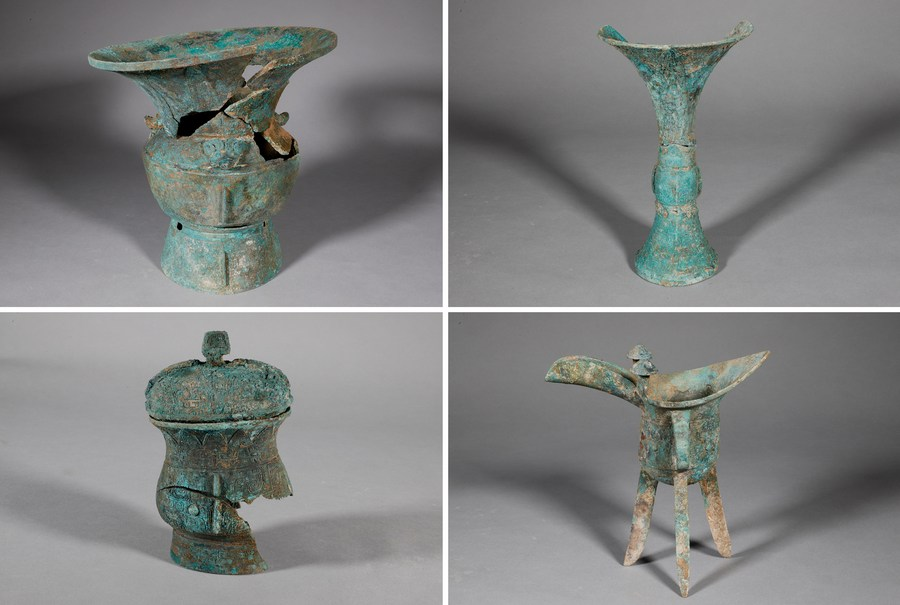Yinxu royal grave ruins on honor list
 0 Comment(s)
0 Comment(s) Print
Print E-mail China Daily, March 29, 2023
E-mail China Daily, March 29, 2023

Bronze vessels from the Yinxu Ruins, Henan province. (Xinhua/Li He)
The Yinxu Ruins, the 3,300-year-old remains of what was once the capital of the late Shang Dynasty (c. 16th century-11th century BC), have been included in China's top 10 list of archaeological finds of 2022.
The list, released by the National Cultural Heritage Administration on Tuesday, recognizes the royal mausoleum remains at the site in Anyang city, Henan province, as a new find. The Yinxu Ruins were previously made famous by the discovery of the oracle bone inscriptions, the oldest-known Chinese script.
According to the administration, the list honored 10 outstanding examples of the nearly 1,700 archaeological projects that were carried out nationwide last year.
The first archaeological honor list was released in 1990, and it has been an annual tradition since. A 21-member panel, comprised of China's top scholars, voted through ballots to select the 10 outstanding projects of 2022 from 22 finalists.
Yinxu was the first independent excavation project carried out by Chinese academics almost a century ago and it now holds a sacred place in the annals of China's archaeological history.
Sacrificial pits and trenches surrounding the royal graves discovered at Yinxu last year have reshaped people's understanding of Shang burial customs and the grand picture of the dynasty as a whole, according to archaeologists.
Xia (c.21st century-16th century BC), Shang and Zhou (c.11th century-256 BC) — the earliest dynasties in traditional Chinese historiography with fewer historical records — have always been the focus of researchers, as they are believed to be the key to decoding the origins of Chinese civilization.
In addition to the royal mausoleum ruins at Yinxu, the top 10 list includes the crisscrossing road network at Erlitou in Luoyang, Henan province. The site is widely believed to have been the capital of the Xia Dynasty toward its end. The Xitou archaeological site in Xunyi county, Shaanxi province — with its high-level tombs and remains of an ancient city, believed to be the native place of the Zhou people — also made the final cut.
"The three sites have groundbreaking value," said Wang Wei, director of the Chinese Academy of Social Sciences' Academic Division of History.
Archaeologists were hugely surprised to find the fossil of a human skull, about 1 million years old, at the Xuetangliangzi site in Shiyan, Hubei province, last year. Labeled as "skull No 3 of the Yunxian man", it was found on May 18, 2022, exactly 33 years after "skull No 1 of the Yunxian man "was found nearby.
"Skull No 3 is the best-preserved skull fossil of its time ever found in the hinterlands of the Eurasian region," said Lu Chengqiu, leader of the archaeological team at Xuetangliangzi. The site is the one with the longest history that made it to the 2022 top 10 list.
"It (the fossil) is a world-class discovery; we have rarely ever found complete human skulls in Eurasia. … It offers us important material to study human evolution in East Asia," said Chen Xingcan, director of CASS' Institute of Archaeology.
Last year, archaeologists found a makeshift human camp, dating back 11,000 to 15,000 years, at the Zhaojiaxuyao site in Zibo, Shandong province. There were remains of fireplaces, animal bones and pottery items.
"Discoveries made at the site filled the gaps in our understanding of the transition period between the Paleolithic and Neolithic ages. … The site is helping us study the origins of agriculture and pottery in Northern China," Chen said.
Some archaeological finds last year shed light on how various ethnic groups communicated with each other in ancient times. For example, the grave complex at Dasongshan site, Gui'an New Area, Guizhou province, which spanned more than 1,400 years — from the Western Jin Dynasty (265-316) to the Ming Dynasty (1368-1644).
"The funerary objects unearthed include porcelain and bronze mirrors, with characteristics of the Central China Plain, and also cultural relics with the styles of other ethnic groups," said Huo Wei, a professor at Sichuan University in Chengdu.
The Shuomen port ruins in Wenzhou, Zhejiang province, is a classic example. Archaeologists have found architectural remains, shipwrecks and a large quantity of pottery and porcelain items at the site that was a port that prospered during the Song (960-1279) and Yuan (1271-1368) dynasties. "It is the most important discovery made in the country that is linked to the Maritime Silk Road," Huo said.
"Last year witnessed fruitful results in archaeological studies in China," said Guan Qiang, deputy director of the National Cultural Heritage Administration. "Active excavations made a better proportion of the archaeological projects, and scientific and technological measures played a key role in them," he added.






Go to Forum >>0 Comment(s)